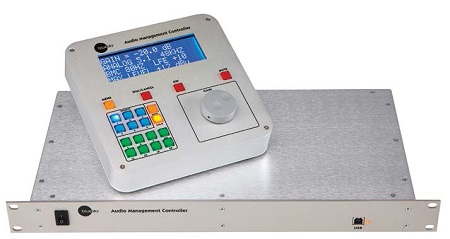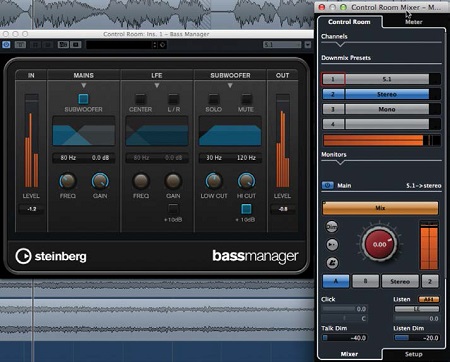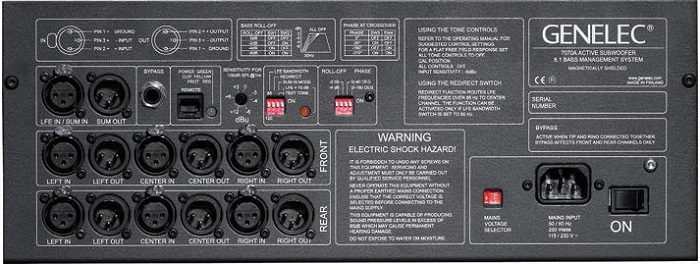Control Rooms: It’s All About the Bass
SAN ANTONIO, TEXAS— The importance of bass managing control room speakers was made crystal clear to me in May 2004, during the first game of the NBA Western Conference Finals. The audio control room for the event was the first 5.1 room my team had ever built and, in addition to mixing the studio show and wraparound elements in surround, we were receiving a full 5.1 mix from the mobile unit parked at the arena.

Audio Design Labs’ Audio Management Controller
Everything was going well right up to the moment we mixed in audio from the site, which was when we discovered that effects microphones inside the venue were picking up low-frequency energy that was not there before the game started. Unfortunately, this low-frequency content was overwhelming the mix and driving our dynamics processing nuts.
The mix engineer in the truck could not hear the problem and it took us a little while to figure out that the main speakers in the truck were not reproducing those low frequencies because they were each fed directly from a console monitor output. This meant that none of the low-frequency content from the main channels was being sent to the subwoofer where it could have been reproduced.
In a large audio mix room with good acoustics, thick walls and full-range speakers, this would be no problem, but mixing audio in a remote truck is essentially mixing in the polar opposite of that environment. Had the truck speakers been bass-managed, the mix engineer in the truck would have corrected the problem immediately without getting a call from the studio control room.
REPRODUCING ALL FREQUENCIES
Bass management ensures the speaker system can reproduce all frequencies of content in the mix so the engineer can actually hear what is going on. Oddly, making this happen seems to have become more difficult as the need for it has increased. Audio control rooms used to have large speakers that could reproduce frequencies below 80 Hz, even though NTSC television had a limited frequency response of around 50 Hz–15 kHz and all of about 40 dB of dynamic range on a good day.

Nuendo Bass Manager plug-in
Mixing for analog television meant rolling off and filtering high and low frequencies, carefully controlling levels with limiters and compressors, and trying not to trigger any processing downstream that would destroy the mix. NTSC became ATSC and we suddenly had five audio channels with 20 Hz–20 kHz frequency response, 100+ dB of dynamic range and a band-limited low frequency effects (LFE) channel that requires its own speaker.
Unfortunately, the installation of subwoofers did not make up for the fact that mix rooms and their main speakers were shrinking. It seems that as soon as we started creating content with significant low-frequency energy, many facilities stopped installing control room speakers capable of letting us hear it, or building rooms with enough space in them to handle that energy.
The smaller near-field speakers found in control rooms now are much less likely to be able to adequately reproduce low frequencies below 80 Hz properly, if at all, and it is difficult for their frequency response to remain linear at lower frequencies. This creates a real problem for the mix engineer since audio that cannot be heard in the control room will still make it to the home. Worse still is the fact that practically all home surround systems bass-manage automatically, sometimes to make up for the fact that their main speakers are small.
At the creation end of the chain, bass managing means redirecting frequencies that cannot be reproduced by the five main speakers into the subwoofer. Subs get a bad rap as just being there to make things shake, but a properly placed and set-up subwoofer can actually smooth out low-frequency problems in small rooms and, when used for bass management, allows smaller speakers to operate more efficiently because they aren’t wasting power trying to reproduce frequencies they weren’t designed for.
Subwoofer speakers are also necessary for proper reproduction of the point one (.1) LFE channel, which was designed specifically to make sure the low-frequency portions of audio effects are adequately represented. Bass management never adds content to the LFE channel, but it does redirect low-frequency content from the main channels into the subwoofer along with it.

Genelec PD7070A15 subwoofer connectors
IMPLEMENTING BASS MANAGEMENT
Actually implementing bass management is generally not difficult, but can be expensive. The speaker system we used for Western Conference Finals had bass-management features built into the subwoofer, so changing our control room and mobile unit setups meant running the monitor channels to the subwoofer first, then to their respective speakers.
Speaker systems without this feature require a monitor controller or audio console monitoring section with built-in bass management that then feeds the speakers. There are also a number of software options available, either included in digital audio workstation monitoring sections or as plug-ins.
No matter the method, the principle is the same. A low-frequency crossover point is selected—usually 80 Hz—and audio below that frequency is redirected from the main monitor channels to the subwoofer. This ensures that low-frequency content makes its way to a speaker that is capable of reproducing it. Since sound becomes omnidirectional as we reduce frequency it is more difficult (but not necessarily impossible) to pinpoint the source, so using one speaker for low-frequency content works fairly well.
Anyone mixing on speakers that are not gigantic, full-range monsters should give serious consideration to bass managing their speaker system if they really want to hear everything in the mix, especially if a subwoofer is already a part of that system. Those mixing in small rooms would also do well to assess whether bass managing their system along with proper subwoofer placement would help sort out some of the acoustic problems inherent in those spaces.
Jay Yeary is a broadcast engineer and consultant specializing in audio. He is an AES Fellow as well as a member of SBE and SMPTE. He can be contacted through TV Technology or attransientaudiolabs.com.
Get the TV Tech Newsletter
The professional video industry's #1 source for news, trends and product and tech information. Sign up below.
